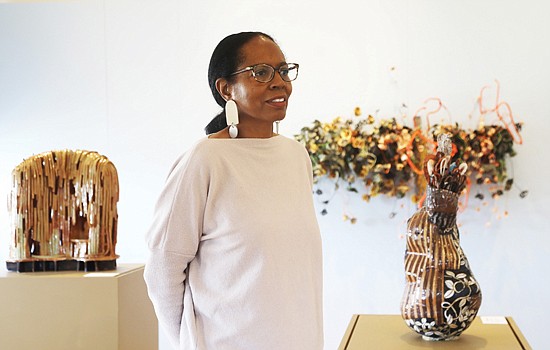Black stereotypes in ceramic art at BHMCC
Jennifer Robinson | 3/28/2024, 6 p.m.

Exploring Black stereotypes in ceramic works may seem like a new trend but it’s not.
With two exhibits in Richmond this spring, ceramic art lovers can explore what’s left behind when physical structures are left behind in “Like the Dust Settles, So Does The Story,” which runs through Aug. 17 at the Black History Museum & Cultural Center of Virginia. Patrice Renee Washington’s solo exhibit “Tendril,” which investigates structures of race, class, and gender, will run through June 9 at ICA at VCU.
Both exhibits offer a thought-provoking and captivating exploration of the African-American experience through the permanence of clay.
Lydia C. Thompson organized “Like the Dust Settles,” which was curated to complement the Multicultural Fellowship Exhibition at the 58th National Council on Education for the Ceramic Arts (NCECA) convention last week at the Richmond Convention Center. The exhibit invites viewers to challenge stereotypes related to communities, environments, race, economics, and societal roles, focusing on self-reflection, strength, and the beauty of resilience during challenging times.
Ms. Thompson, a professor of art and former department chair at the University of North Carolina at Charlotte, received a 2024 NCECA Honorary Member Award at the convention.
She also has held positions as the Director of the School of Art at Texas Tech University, Department Head at Mississippi State University, and Assistant Dean of Undergraduate Studies at Virginia Commonwealth University
Her work has been included in galleries, art centers, and museums such as the Society for Contemporary Crafts in Pennsylvania; Baltimore Clayworks; the Ohr O’Keefe Museum in Biloxi, Miss.; the Kentucky Museum of Art and Craft; The Temauta Gallery in New Zealand; and Guldegaard in Denmark.
Ms. Thompson’s art explores what’s left behind in dwellings when people move on. She focuses on forced displacement, whether it’s migration or gentrification.
“Like the Dust Settles” is a group exhibit featuring artists who share a common language of manipulating clay to illustrate the changing conditions of moments passing through time. It captures moments of intentional and unintentional inflictions within communities.
I spoke with her about the group exhibit and her work to understand what’s left behind when people leave structures like their homes. Ms. Thompson describes it as the physical ruins, accumulation of personal belongings, and remaining structures that become the histories of people and their physical environment.
Free Press: Why do you refer to the necessity for ruins to describe the theme of this exhibit?
Ms. Thompson: I don’t see ruins. I wonder about the stories behind abandoned buildings. In his book, “The Necessity for Ruins and Other Topics,” J.B. Jackson discusses the interval of neglect and the need for discontinuity as religiously and artistically essential.
Ruins provide the incentive for restoration and a return to origins. However, the works by the artists in “Like the Dust Settles” invite audiences to reconsider stereotypes, whether they are physical objects or a mental state — race and racial identities, economics, and one’s place in society.
Free Press: What provokes your curiosity about what’s left behind?
Ms. Thompson: I felt the swell with ceramics years ago. It’s such a friendly form, but all art forms make spiritual connections based on the experience of what I may be reading and learning. I’m inspired by writers such as Isabel Wilkerson, the best-selling Pulitzer Prize-winning author, who wrote about Black migration in the “Warmth of Other Suns.” Octavia Butler, Zora Neale Hurston, and Toni Morrison also have inspired me with their stories of the African-American experience.
Free Press: Why this exhibit, and why now?
Ms. Thompson: I had an inspiring conversation with Jstn Clmn, one of the artists in the exhibit. He works with handmade ceramics and found object ceramic materials—plates and bowls, infusing shards. We began creating a list of artists with similar ceramic works.
The objects, containers, and structures produced by the artist in the exhibit resonate and capture the physical presence left behind by communities in cycles of urbanization and gentrification. The work references personal or shared histories, daily rituals, and practices of a culture.
Free Press: What can we expect from “Like the Dust Settles?”
Ms. Thompson: It’s a combination of very diverse, colorful, muted, monotone, linear and mixed media. Each artist has different interpretations of ruins and approaches to how they see the structures. There’s some interesting work about urban decay.
In it, there’s something beautiful about holding on to what’s left behind. It’s about wondering what the furniture and walls would say if they could talk.
The art in the exhibit infuses and merges ideas of suppression, composition, possession, and rebirth through the physical act of working with clay. It also depicts clay’s properties of fragility, hardness, and strength, permanency, and demonstrates the cycles of life.
Free Press: What’s next for you?
Ms. Thompson: I would love to travel the exhibit, but it will most likely end in August. I’m currently prepping for another exhibit in Portchester, N.Y., and I’m very excited about showing my work there.







